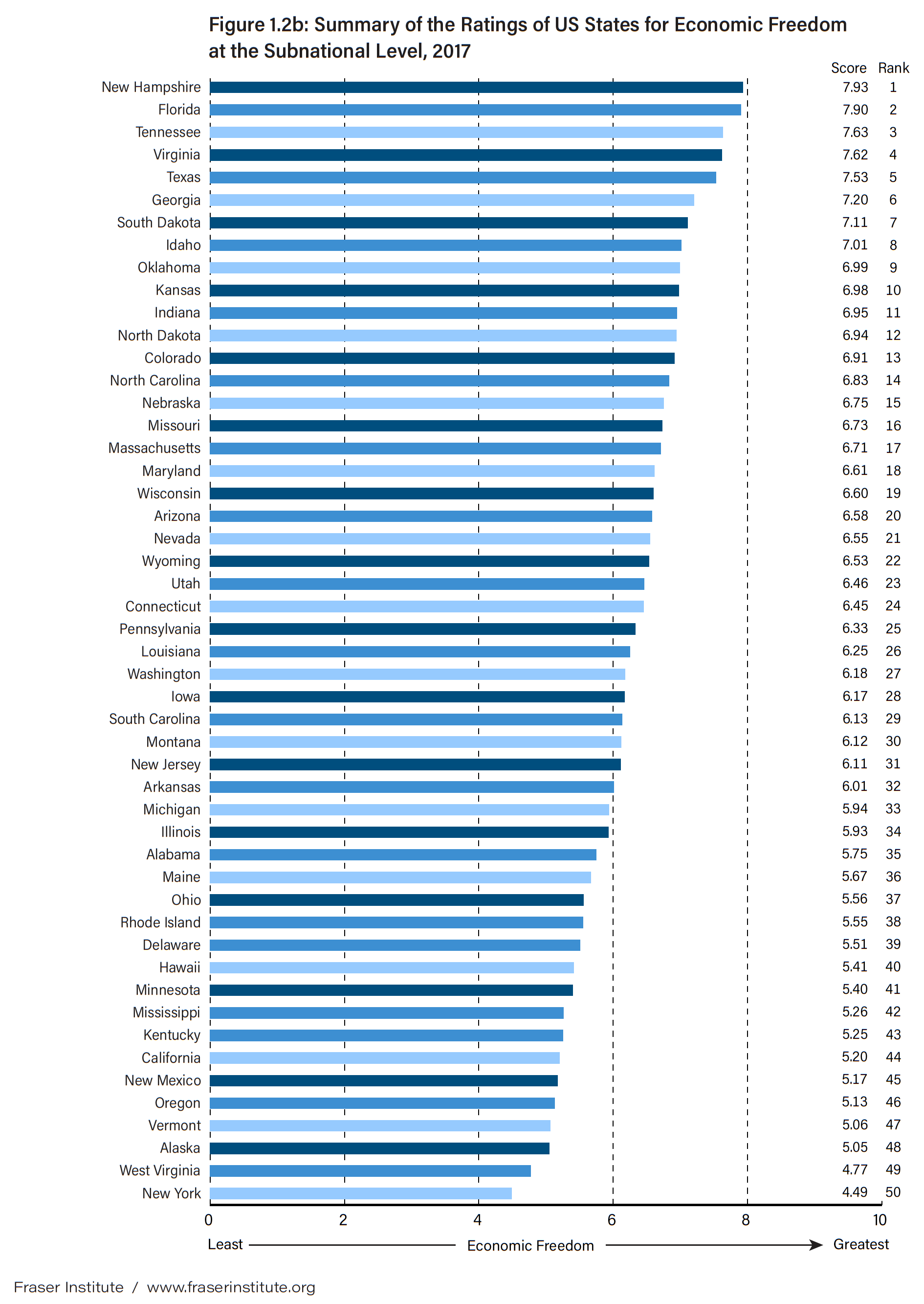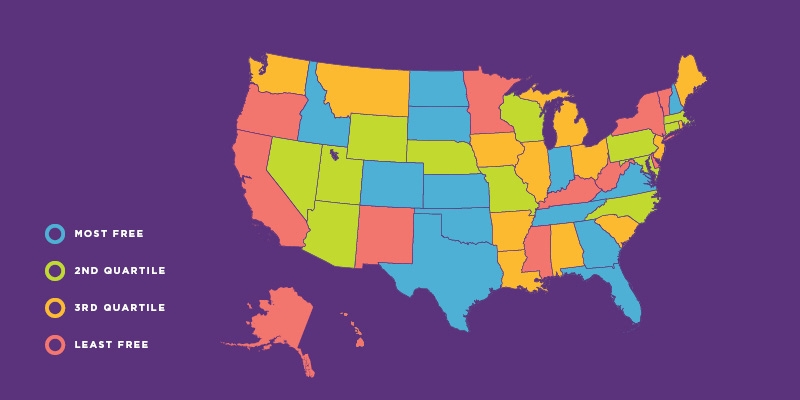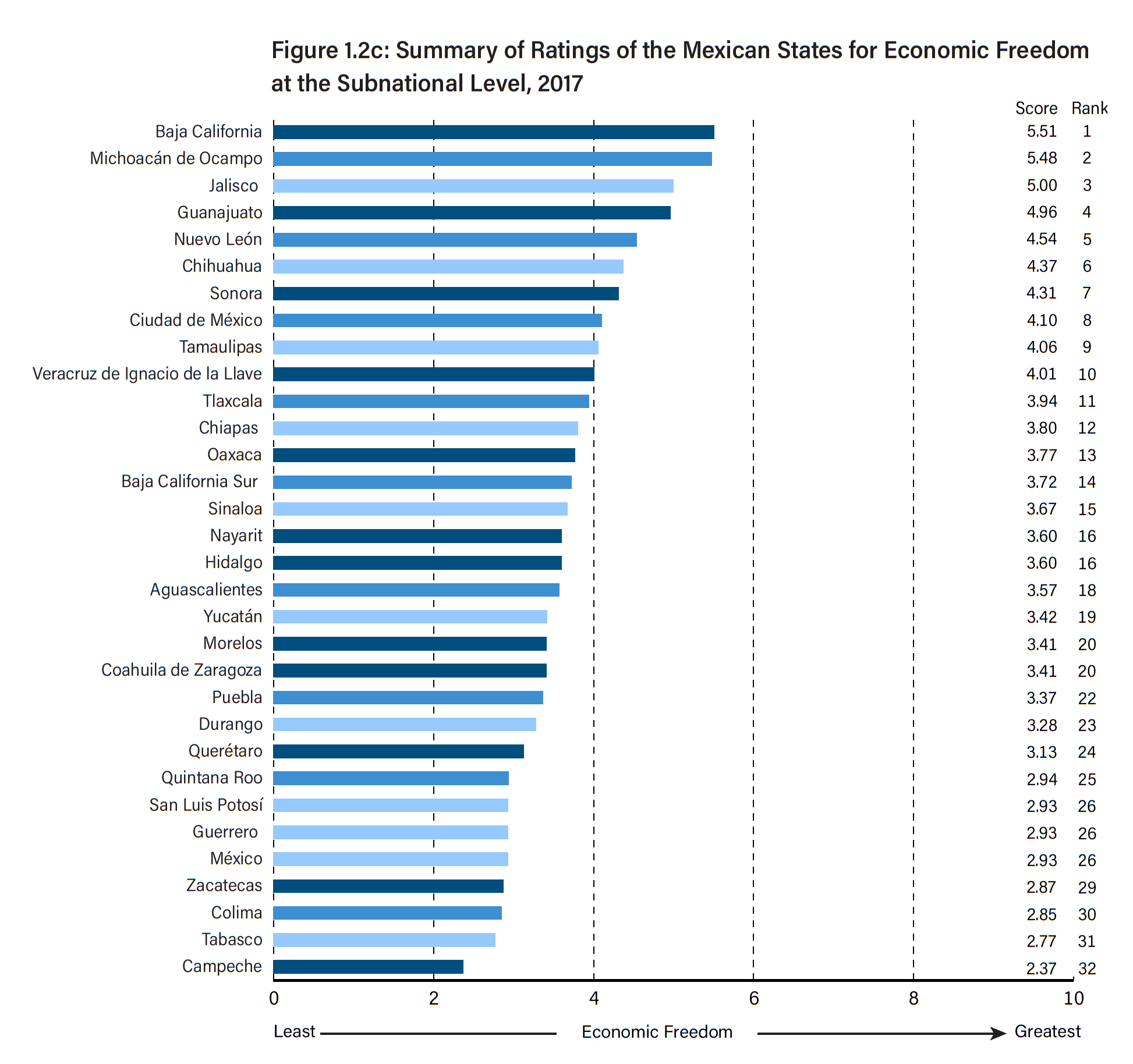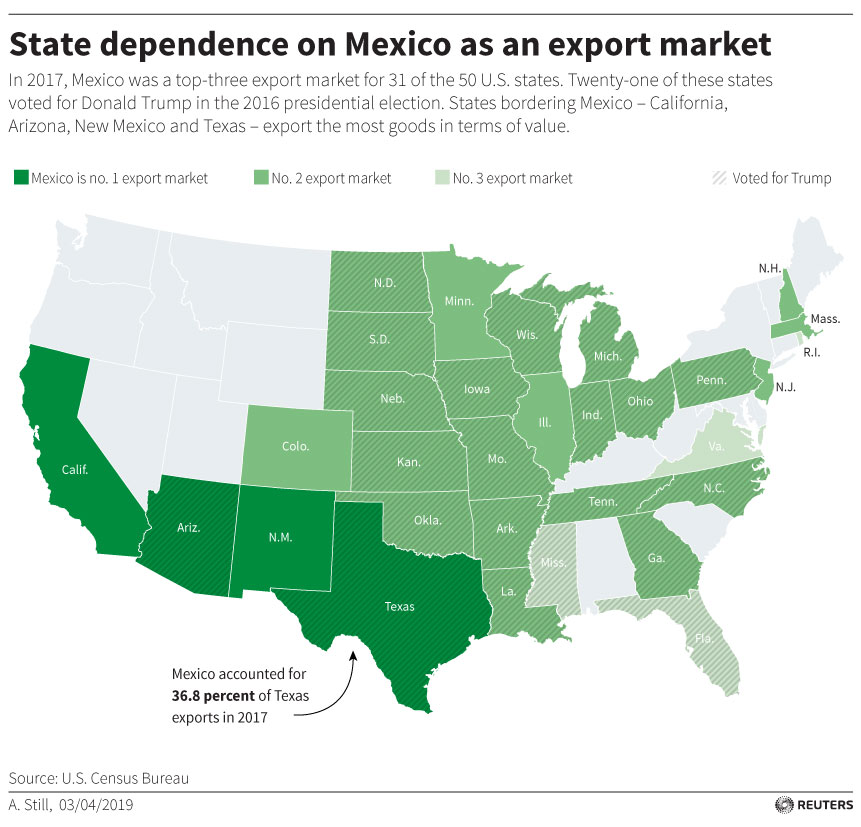How To Be a Good Neighbor by Being a Role Model — The United States, Mexico, and Economic Freedom
The Fraser Institute recently published new editions of its annual rankings of economic freedom in North America and around the world. These rankings, together with scholarly studies on the spread of economic freedom, tell an interesting story about Mexico and why it is important for the United States to be a good neighbor by being a role model.
In November 2019, Fraser released Economic Freedom of North America 2019 (EFNA), the 15th edition of its annual report measuring the extent to which “the policies of individual provinces and states were supportive of economic freedom, the ability of individuals to act in the economic sphere free of undue restrictions.” The report is based on 2017 data, the year with the most recent comprehensive data.
Economic Freedom in U.S. States
The table below lists the 50 U.S. states from most economically free to least economically free. The top state is New Hampshire, living up to its “Live Free or Die” motto, followed by Florida and Tennessee. Virginia is fourth and Texas is fifth. The least-free state is New York, following West Virginia, Alaska, Vermont, and Oregon at 46th.
The nation’s most populous state, California, is among the least free. The Golden State is ranked 44th—the seventh least-free state in the nation. Californians are responding to the lack of economic freedom by voting with their feet and fleeing the state in large numbers.
Testimonials and patterns of movement reveal a lack of affordable housing to be a major factor among people looking elsewhere to achieve the American dream. But California’s high housing costs are the result of government restrictions on the economic freedom to build new housing or convert older structures into residential units. Burdensome regulations at the state and local levels artificially reduce the supply of housing and increase home and rental prices. During the past 10 years, median home sale prices in California have increased by 72 percent, while median household annual income only increased by about 6.5 percent. (For a comprehensive analysis of California’s housing affordability crisis, read my report How to Restore the California Dream: Removing Obstacles to Fast and Affordable Housing Development, 2020).
The lack of economic freedom in California to build new housing or to convert older buildings into residential units has caused a mass exodus from the state, particularly among lower-income and middle-class residents and the less educated. The U.S. Census Bureau’s American Community Survey has shown a consistently negative net domestic migration for California during the past several years: more people left California for other states than came to California from other states. On net, from 2007 to 2018, California lost nearly 1.3 million residents to domestic migration (see here and here). And since 2016, overall net migration, which includes international migration into California, has been negative in the Golden State.
The 2019 U.S. economic freedom results can be depicted visually, as well (see the map below). The freest states (in blue) tend to be in the South and through the Great Plains, with noticeable groupings among states in the first and second quartile, respectively. Interestingly, the least-free states (in salmon) are scattered throughout the country. There are no large groupings, only a few side-by-side neighbors: California and Oregon; Kentucky and West Virginia; and New York and Vermont, for example. This may indicate that public policies that expand economic freedom spread to neighbors more consistently than do policies that restrict economic freedom (more on this point below).
Economic Freedom in Mexico States
Perhaps the more interesting patterns that I observed in the new EFNA report involves Mexico states. The following table lists all 32 states in Mexico by their level of economic freedom from best to worst. Baja California has the most economic freedom, while Campeche is at the bottom of the barrel. The spatial distribution of economic freedom is telling.
Of the six Mexico states that border the United States, only Coahuila falls below the top-nine states: Baja California 1st; Sonora 7th; Chihuahua 6th; Coahuila 20th; Nuevo Leon 5th; and Tamaulipas 9th, from west to east. Mexico states along the U.S. border tend to be some of Mexico’s most economically free. For reference, the map below shows the location of Mexico states.
In contrast, Mexico states farthest from the United States have some of the worst levels of economic freedom: Campeche is dead last at 32nd; Tabasco is 31st; Guerrero 26th; and Quintana Roo 25th. What explains these patterns?
The Economic Freedom “Spillover Effect”
The two patterns of economic freedom inside Mexico, though not correlated perfectly state-by-state across the country, nevertheless are generally consistent with a “spillover effect” of economic freedom. Scholars have identified such an effect in their research on the global diffusion of institutions. Specific to Mexico, the increased trading opportunities and competition coming from the north—the United States generally and its individual southern border states—exert pressure in Mexico to improve its economic freedom, especially within its northern border states. The same pressures do not exist in Mexico’s southern states.
Let’s examine these pressures using economic data: (1) national/federal comparisons of economic-freedom levels; (2) state comparisons of economic-freedom levels; and (3) statistical scholarly studies on the diffusion of economic freedom, capitalism, and democracy.
According to the Fraser Institute’s Economic Freedom of the World: 2019 Annual Report (EFW), published in September 2019, Mexico ranks 76th globally in economic freedom, while the United States ranks 5th, one spot better than its 6th-place ranking in 2018. There is a huge disparity, therefore, in the general level of economic freedom in Mexico compared to the level of economic freedom in the United States, and this exerts pressure on Mexico from the north to change.
In contrast, Mexico does not face the same economic-freedom pressures from the south: Belize is ranked 85th, Nicaragua is 74th, El Salvador and Honduras are tied at 63rd, while Costa Rica ranks 46th. Only Guatemala (34th) and Panama (31st) rank considerably better than Mexico, yet neither country approaches the top 20.
Drilling down further to the state level, despite the low level of economic freedom in California (44th) and New Mexico (45th) relative to other U.S. states, both of these states have significantly more economic freedom than any Mexico border state (see the “All Government” rankings on page 4 of EFNA). And both Arizona (20th) and Texas (5th) are in the top two quintiles in the United States. Trade patterns reinforce simple geography, as well.
The top Mexico state for Texas exports is neighboring Chihuahua. Similarly, the top Mexico state for California exports is neighboring Baja California (see table 5 of Ismael Aguilar Barajas, et al., “Trade Flows Between the United States and Mexico: NAFTA and the Border Region”). Ismael Aguilar Barajas, et al., perform a detailed statistical analysis of the economic relationships between Texas and the northeastern states of Mexico: Chihuahua, Coahuila, Nuevo Leon, and Tamaulipas. They conclude, “In the case of the Texas-Northeastern Mexico region, before NAFTA [North American Free Trade Agreement], Northeastern Mexico’s economy was already more integrated with Texas than was the case of the rest of Mexico; NAFTA only increased this differential.”
Reuters prepared a heat map of the United States illustrating the importance of Mexico as a destination for exports from U.S. southern border states. Mexico is the top export market for all four U.S. border states.
The upshot is that U.S. southern border states exert additional, independent pressure on Mexico, especially on Mexico’s northern border states, to increase economic freedom, because of geographic and trade effects (more on this point below). Statistical studies also support the “spillover hypothesis.”
Scholarly Studies Supporting an Institutional “Spillover Effect”
Observational evidence based on comparisons of economic-freedom levels suggests that greater economic freedom in the United States has a beneficial spillover effect on the level of economic freedom in Mexico states that border the United States. The effect is less pronounced, or absent, in southern Mexico states, farthest from the United States. This “spatial-diffusion” effect, to borrow a phrase from econometricians, is supported by statistical analysis of the spread of democracy, capitalism, and economic freedom.
In the journal article “International Diffusion of Liberalism” (International Organization, 2006), Beth A. Simmons, Frank Dobbin, and Geoffrey Garrett identify four potential mechanisms of institutional diffusion: (1) Tiebout competition and migration of people and companies, (2) a demonstration effect or “learning by observing,” (3) economic communities or zones, and (4) emulation of a “big player” country. Although not exhaustive, the list summarizes some of the major channels of diffusion of institutions both within countries and between countries.
Joshua C. Hall, Donald J. Lacombe, and Timothy M. Shaughnessy review scholarly studies on institutional diffusion in their journal article “Economic Freedom and Income Levels Across U.S. States: A Spatial Panel Data Analysis” (Contemporary Economic Policy, 2018). They conclude:
There are strong theoretical reasons based on Tiebout (1956) and yardstick competition (Brueckner and Saavedra 2001) to think that economic policies are spatially related. Recent empirical work by Leeson and Dean (2009) shows that democracy and economic freedom spread geographically across countries, that is, that changes in a country’s economic or political institutions “spill over” to nearby countries.
Hall, et al. (2018) note that “since economic freedom spills over to nearby [U.S.] states (likely because of yardstick or Tiebout competition), it is important to account for how an increase in one state’s economic freedom affects neighboring states’ real per‐capita GSP [gross state product]” through the ripple of increased economic freedom.
The researchers analyze state real per-capita GSP from 1981 through 2012, accounting for both direct and indirect effects, and conclude, “as the economic freedom in a particular state increases by 10 percent, real per‐capita GSP in surrounding states increases by 4.7 percent, on average. . . . [W]e show that there are positive spillovers in economic freedom.” When one state increases its economic freedom, there is a ripple effect in surrounding states as they also expand economic freedoms, resulting in an increase in the real per-capita income in neighboring states.
The Leeson and Dean (2009) study that Hall, et al. referred to in the quote above is “The Democratic Domino Theory: An Empirical Investigation” (American Journal of Political Science, 2009). Peter T. Leeson and Andrea M. Dean examine the spread of democracy, which may include associated institutions that enhance economic freedom such as more secure private property rights. According to the “democratic domino theory,” changes in the political institutions in one country, in this case democracy, spread to neighboring countries, increasing or decreasing their democracy similarly, which spreads to their geographic neighbors, and so on.
Leeson and Dean use spatial statistical analysis to examine more than 130 countries between 1850 and 2000, and found that “democratic dominoes do in fact fall as the theory contends. However, these dominoes fall significantly ‘lighter’ than the importance of this model suggests. Countries ‘catch’ only about 11 percent of the increases or decreases in their average geographic neighbors’ increases or decreases in democracy.”
Similarly, in their journal article “Comparing the Spread of Capitalism and Democracy” (Economics Letters, 2012), Peter T. Leeson, Russell S. Sobel, and Andrea M. Dean examine the “domino theory’s economic side,” specifically, they apply the methodology used by Leeson and Dean (2009) in their study of the spread of political institutions (democracy) to now study the spread of economic institutions (capitalism).
The researchers use Fraser Institute’s EFW score for each country to measure each country’s level of “capitalism,” 1985 through 2005; thus, they provide a direct test of the economic freedom spillover hypothesis. The statistical analysis shows that capitalism spreads between neighboring countries, and that “capitalism and democracy spread at approximately the same modest rate” of about 10 percent to 15 percent.
In an earlier 2007 study, Russell S. Sobel and Peter T. Leeson look at the international diffusion of economic freedom through two channels in “The Spread of Global Economic Freedom” (Economic Freedom of the World: 2007 Annual Report, chapter 2, 2007). The researchers look for evidence of the geographic spread theory, whereby economic freedom, or the repression of it, spreads directly to contiguous geographic neighbors. They also search for evidence of the trade spread theory, whereby economic freedom, or the lack of it, spreads directly between countries that are trading partners, regardless of whether they are geographic neighbors. The results in this study are not directly comparable to the results in Leeson, et al. (2012) due to different specifications and to data from different years.
Sobel and Leeson construct a panel of economic freedom ratings in 102 countries between 1985 and 2000. Their statistical analysis finds that “indeed economic freedom does spread geographically.” Specifically, the geographic results imply that a country “i” whose geographic neighbors are on average one unit freer (based on EFW ratings) than the neighbors of some other country “j” is on average 0.2 units freer than “j”, in other words a 20 percent boost.
The statistical analysis examining the spread of economic freedom through trade provides some cautious evidence that “trade is a better route by which to spread economic freedom.” Rather than the geographic effect of 0.2, the international trade effect is 0.32—economic freedom spreads stronger through trade than through geography (where the economic freedom of other countries is measured here by the import-share weighted average of the country’s trading partner’s EFW ratings rather than the average freedom rating of a country’s geographic neighbors).
Sobel and Leeson confirm that both channels matter: “Economic freedom does indeed spread through both geography and trade, in both levels and changes.” There is some cautious evidence that economic freedom spreads stronger between trade partners than between geographic neighbors, but “countries ‘catch’ about 20 percent of their average geographic neighbors’ and trading partners’ levels and changes in economic freedom.”
Finally, there is a body of literature on “policy diffusion” showing that governments adopt neighbors’ policies. Leeson and Dean (2009) connect these studies to the four channels of diffusion mentioned earlier: “Some existing research has found evidence for various kinds of ‘policy diffusion’ via each of the channels pointed to above (see, for instance, Elkins, Guzman, and Simmons 2006; Gleditsch and Ward 2006; Lee and Strang 2006; Swank 2006).”
The upshot is that democracy, capitalism, and economic freedom, or the lack of it, spread between geographic neighbors and between trade partners. It is important to note that the influence of the United States on Mexico is likely magnified because the United States is both a geographic neighbor (one of only three for Mexico) as well as Mexico’s top trade partner. A full 80 percent of Mexico’s exports went to the United States in 2017, according to the most recent data from the World Bank, while 46 percent of Mexico’s imports came from the United States. For both Mexico exports and imports, the United States ranked as Mexico’s top trade partner.
The spread of economic freedom from the United States to Mexico, especially to Mexico’s northern border states, is reflected in specific policies that Mexico adopted throughout the years.
Mexico Economic Policies and the Spread of Economic Freedom
In response to the end of the Bracero Program in 1964—a guest worker agreement between Mexico and the United States begun in 1942—Mexico enacted the Border Industrialization Program in 1965, which created special economic zones (SEZs). These zones were intended to stimulate employment and economic growth, especially in border cities, and to encourage foreign investment and “hard currency” accumulation inside Mexico. The factories located inside the SEZs were called maquiladoras.
Under the original legal structure, a maquiladora was a factory in Mexico that imported inputs from a country, say the United States, assembled or processed the inputs to add value, and then exported the finished products to the country, in our example the United States. The inputs and machinery used to manufacture the good could be imported into Mexico duty free, and the United States typically levied a duty only on the value-added portion of the exported good. Under Mexican law, a maquiladora could be fully owned by foreigners if a certain percentage of the goods were exported and not sold domestically inside Mexico.
Until 1972, maquiladoras had to be located within 20 kilometers of the U.S. border and they had to export all of their goods. After 1972, they could be located anywhere in Mexico and were allowed to sell a percentage of their goods domestically; thus, economic freedom did expand.
Special regulatory breaks were issued for maquiladoras in the mid-1980s and the economy was opened to foreign direct investment. But maquiladoras remained concentrated along the northern border with the United States because of the geographic trading advantage of being close to the U.S. market.
The purpose of the maquiladora program was to make Mexico companies and workers more competitive with the United States—more evidence of the geographic- and trade-spread theories. The expanded economic freedoms resulted in trade liberalization that spurred maquiladoras. According to Joshua A. Cohen in his article “The Rise of the Maquiladoras,” from 1980 to 1995, the number of maquiladoras jumped from 539 to more than 2,000. And the number of people employed by maquiladoras increased to 776,000, or about 10 percent of Mexico’s labor force. By 1996, maquiladoras were the second-largest industry in Mexico behind oil.
With implementation of the 1994 North American Free Trade Agreement (NAFTA), the rules impacting maquiladoras were implemented in two phases. The first phase from 1994-2000 permitted maquiladoras to continue importing products into Mexico duty-free, regardless of where the products originated. The first phase also allowed maquiladoras to increase their sales into Mexico domestic markets.
Duty-free status for a given import in the second phase after 2000 was determined by the new North American rules of origin. The bottom line, as summarized in a 2019 report by the U.S. Congressional Research Service, is that in 2001 and beyond, “The initial maquiladora program ceased to exist and the same trade rules applied to all assembly operations in Mexico.” Mexico’s government imposed the same import duties on residents in border zones as in other parts of Mexico. The special privileges once enjoyed by border SEZs were eroded, but overall trading opportunities with the United States and Canada increased because NAFTA opened markets.
As observed by Nina Ebner and Mateo Crossa in NACLA, “The signing of NAFTA in 1994 expanded the viability of the maquiladora industry,” but with a different legal structure than the original companies. By 2000, as reported by University of California, San Diego, professor Gordon H. Hanson, “The maquila sector generated 48 percent of Mexico’s exports and 35 percent of the country’s imports. These plants remain concentrated in Mexican states along the Mexico-U.S. border, which in 2002 accounted for over 80 percent of total maquiladora employment.”
Recently, Mexico president Andres Manuel Lopez Obrador (AMLO), who assumed office on December 1, 2018, created a new SEZ along the country’s northern border intended to increase investment, create jobs, and spur economic opportunities.
On December 29, 2018, AMLO announced the “Tax Incentive Decree for the Northern Border Region,” which created a 15.5-mile (25-kilometer) SEZ along the U.S. border from the Pacific coast to the Gulf of Mexico, or nearly 2,000 miles long. The so-called “free zone” encompasses 43 municipalities across six Mexico border states. Initially, the free zone will last for two years (2019 and 2020) at which point it will be evaluated for continuation.
Communities within the zone are able to offer a reduced corporate and individual income tax rate (from 30 percent to 20 percent for corporations, and from 35 percent to 23 percent for individuals), and a lower value-added tax (VAT) on goods coming into the country (from the national rate of 16 percent to a new lower rate of 8 percent). The minimum wage is doubled (to about $9 per day) in the SEZ, under the assumption that a higher minimum wage will stem northward migration into the United States.
In announcing the SEZ, AMLO said, “It’s going to be the biggest free zone in the world. It is a very important project for winning investment, creating jobs, and taking advantage of the economic strength of the United States.” AMLO’s ultimate goal is to create such zones from south to north in Mexico in order to make businesses and factories in Mexico more competitive. Notably, and consistent with the spillover hypothesis, AMLO and other government officials decided to open their first free zone in the north along the U.S. border and cancelled seven southern SEZs.
In late 2017 and early 2018, Mexico’s President Enrique Pena Nieto created special economic zones in seven southern municipalities. Each SEZ offered generous tax breaks, but also came with stringent, bureaucratic qualifying conditions. The zones never took off, in fact, no permissions to operate were ever granted. Ultimately, in April 2019, AMLO cancelled all seven zones, saying the zones “were supposed to help but they never did anything to help. They [the former government] did business, they bought land, they squandered resources [but] there was no benefit at all.”
Mexico’s experience with special economic zones demonstrates that incentives matter; thus, it would be best if Mexico’s government permanently extended AMLO’s new tax reductions throughout the country—make all of Mexico a “free zone”—which would exert pressure on Mexico’s southern neighbors and trade partners to increase their economic freedom as well.
Conclusion: The United States Should Be a Good Neighbor by Being a Role Model
An important lesson gleaned from the evidence is that the United States can exert pressure on others, especially its neighbors and trading partners, to increase their economic freedom by being a role model. As noted by legendary college basketball coach John Wooden, who knew a thing or two about motivating others, “Being a role model is the most powerful form of educating.” If we want stable and prosperous neighbors to the south and globally, we need to be a role model ourselves and continually expand our economic freedom. Doing good becomes a virtuous cycle; doing bad becomes a death spiral.
This lesson has implications for President Donald Trump’s trade wars and on-again-off-again trade negotiations. Sobel and Leeson (2007) remind us, “By liberalizing their trade with foreign nations, economically free countries can exert at least a modest positive impact on economic freedom in less free nations.” But shared liberalization is even more impactful: “Widespread regional changes in freedom do build momentum and have the highest impact on neighboring countries. . . . Free-trade agreements that allow a number of nations to simultaneously coordinate trade liberalization could have a sizable influence on spreading economic freedom to economically repressed regions of the world.”
When countries liberalize trade together, it causes other countries to liberalize trade, and so on. It is important to note that what I have in mind here is true “freedom to trade,” not “government directed trade” or “government managed trade,” which are not true free trade but are typical of most international trade agreements. Trade restrictions, on the other hand, protect inefficient actors and provide a scapegoat for failed regimes around the world to blame “outsiders” for the misery caused by their own poor domestic policies.
Role modeling economic freedom and open trade are the correct policies long term, not only for the United States, but also for its neighbors and trade partners around the world. Trump’s trade wars, in contrast, are dangerous for his own political future and for advancing peace and prosperity around the world.
The Independent Institute is an associate member of the Economic Freedom of the World Network, and an Economic Freedom of North America Network partner organization. I thank Jonathan Hofer for his helpful comments on an earlier draft.























